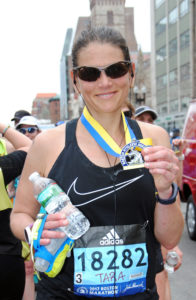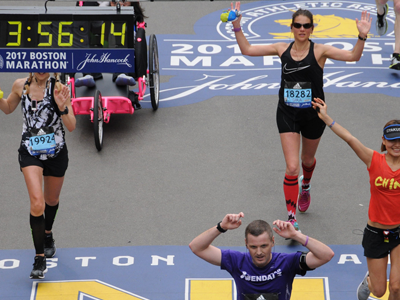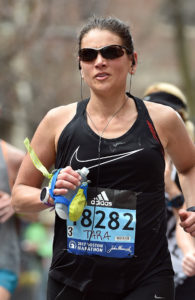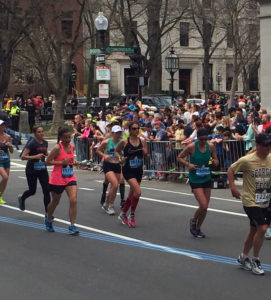Dr. Tara Parks’ Long Journey to the Boston Marathon
About Training, Perseverance, Preventing and Overcoming Foot Injuries
by Tara Parks, DPM
Podiatrist
Boulder Medical Center
Journey to a Runner’s Dream
On April 17, 2017, I was one of more than 30,000 runners who began our 26.2 mile journey running in the Boston Marathon, beginning in Hopkinton, Mass., traveling through 8 cities and towns, and arriving at our final destination: Boston. It is a long journey of perseverance for many to get to Boston and participate in this historic race. The first Boston Marathon on April 19, 1897, was run by only 15 participants. Now, 120 years later, the race is the world’s oldest annual marathon, draws 500,000 spectators, and is one of six World Marathon Majors. Runners who want to run in Boston must achieve a qualifying time (also known as a “BQ”) in a previous marathon to be eligible.
My aspiration to run the Boston Marathon happened somewhat unexpectedly. As a collegiate runner, I always wanted to run a marathon, but didn’t attempt it until 2012 when I ran the Chicago Marathon. Due to a nagging injury that left me unable to adequately train in advance, I only had 8 weeks to prepare. I had no target time for this first marathon; my goal was simply to finish. I was happy with my race time of 3:42, until I realized that I could have qualified for the Boston Marathon if my time had been 3:40 – only 2 seconds faster. Until that moment, Boston had been an afterthought. I came back to Chicago the next year and ran a 3:26 marathon, which gave me my “BQ” for Boston Marathon!
I ran my first Boston Marathon in 2015 and, unfortunately, my maiden voyage in Boston ended in a “Did Not Finish” (DNF) when, running in pouring rain and 40-degree temperatures, I tore my calf muscle at Mile 9 and was forced to stop. Determined to get back to Boston, I ran the Milwaukee Lakefront Marathon later that year to qualify for Boston again, finishing with a time of 3:34. I returned to the Boston Marathon last month for redemption, and although an injury delayed the start of my training cycle earlier in the year, I was able to cross the finish line with a time of 3:54. With warmer than normal temperatures in the upper 70’s, the race was challenging, but I was proud to finally complete this iconic marathon.
Looking back, my training for Boston didn’t begin when my 4-month training plan started in January of this year. It started years before, training for and running in 5K and 10K races, then moving up to half marathons. The mileage started out small and gradually increased over time. The obstacle that many runners face with increasing their mileage is staying Injury-free. One can only be as fit as their injuries allow. I struggle with this challenge and often find myself deciding if the pain I feel is a sign to stop or just muscle soreness. There are times that it is okay to keep running and there are times one must stop and seek medical treatment.
I’ve learned a lot through my journey. With the upcoming Bolder Boulder and summer racing season approaching, here are some suggestions to help you stay injury-free:
Training Tips for Runners
With any race there is a certain amount of training required to be successful and have a good race. Typically, it is recommended to keep your mileage increase to less than 10% per week.
Running Workouts
-
-
- A marathon may seem much more difficult than a 5K or 10K, but even races as short as 3 to 6 miles require a high level of cardiovascular and aerobic fitness.
- A weekly long run improves endurance.
- Strides, intervals, and tempo runs improve speed.
- When you begin training for a 5K, 10K, or even a marathon, there are some great online training plans and one can also consider a running coach. There are also multiple running groups that meet at local running stores (Boulder Running Company, Runners Roost, Fleet Feet Sports, Flatirons Running).
-
Strength Training
-
-
- Strengthening the surrounding muscles can prevent many injuries. I recommend Pilates exercises, core strengthening, and light weightlifting.
- If you already have an injury, I recommend Physical Therapy for specific therapy and exercises.
-
Stretching
-
-
- Stretch before and especially after running.
- Yoga and fascial stretching can be helpful.
-
Optimal Foot Health and Preventing Injuries

Whether it’s a 5K, 10K or marathon race, smart training and a focus on injury prevention can result in a successful outcome.
Foot health is often overlooked by runners. Here are some tips to help you prevent injuries and achieve optimal foot health this season:
Finding the Right Shoe
-
-
- Appropriate running shoes are by far the most important piece of equipment you need to begin any running program. You won’t give yourself a fair chance at running without a good pair of running shoes.
- I recommend runners get fitted at a specialty running store, where they can help find the correct type of running shoe for you. You want to make sure the width and length are correct, but also want them to feel comfortable. Try running in the shoes.
- There are multiple different brands of shoes as well as stability options (Motion Control, Stability, Neutral, Minimalist) and heel drop options (typically 0-12 mm).
- Some shoes work much better for some runners than other shoes depending on the foot type, pronation, deformities, running form, and current injuries.
- One should expect to pay at least $100-120 for a pair of good running shoes.
-
When to Get New Shoes
-
-
- Running shoes will break down. You should switch out your running shoes every 400 miles (even sooner pending the shoe type).
- Also, consider rotating your running shoes by alternating running in two or more different pairs of shoes. This helps to prevent the body from overstressing the same muscles and joints.
-
Recovery Shoe Gear
This includes rest days, massage, stretching, and recovery footwear.
-
-
- Avoid unsupportive shoe gear throughout the day. Often when patients say that foot pain prevents them from running, we discover that the dress shoes they wear all day have no support. Wearing cheap flip flops, high heels, flats, and Converse/Vans without inserts can affect your feet and lead to many foot or lower leg ailments.
- Avoid barefoot walking. I recommend having a good pair of slippers, recovery sandals (Oofos, Hoka), or even just a clean pair of running shoes to wear indoors.
-
Common Running-Related Injuries
These are just a few of the common running related foot problems seen with runners. If the pain has persisted longer than a week or if the pain is preventing you from running, it is recommended to see a podiatric foot and ankle specialist to have the injury evaluated.
Toenails
-
-
- My favorite poster during the Boston Marathon was “Toenails are overrated anyway”. Thankfully, I have never had a black toenail from running, but I am one of the fortunate.
- Prevent toenail problems by wearing appropriately sized running shoes and quality running socks, and by trimming the nails prior to runs.
-
Calluses
-
-
- Use a pumice stone or file to keep the callus down.
- A keratolytic lotion with lactic acid, salicylic acid, or urea can soften the calluses.
- Accommodate foot deformities with padding, orthotics, and wider shoes
-
Stress Fractures
-
-
- Associated with rapidly increasing training volume or intensity or stepping awkwardly.
- Typically, this involves the metatarsals and will express as pain over the top of the foot.
- X-Rays are required and the condition is treated with a walking boot for 6 weeks.
-
Plantar Fascitis
-
-
- Classic symptoms include pain in the heel, which is worse in the morning.
- Treat with ice, stretching, NSAIDS for pain relief, supportive shoe gear, orthotics, night splint, physical therapy, massage.
-
Achilles Tendinitis
-
-
- Classic Achilles tendinitis is within the long tendon at the back of the ankle.
- Treat with ice, stretching, calf strengthening, physical therapy, heel lifts, NSAIDS.
-
Shin Splints
-
-
- Treat with ice, stretching, strengthening, supportive shoe gear, orthotics, physical therapy and nonsteroidal anti-inflammatory drugs (NSAIDs) like aspirin, ibuprofen and naproxen.
- Compression socks can be helpful.
-
The Boston Marathon was my long-term goal once I started running marathons. I achieved it this year and plan to go back in a couple of years to “conquer” that course. Injuries are inevitable. Prevention is key with appropriate training, quality footwear, strength training, stretching, and seeking medical advice early before the injury “curb-sides” you.
Get to know Dr. Tara Parks, DPM
 As a former collegiate runner at Southern Illinois University, Dr. Tara Parks continues to run, competing in half- and full marathons, including completing the Boston in 2017 Dr. Parks has volunteered as assistant coach for the Westminster Coyote Cross Country team and enjoys working with athletes and runners of all ages.
As a former collegiate runner at Southern Illinois University, Dr. Tara Parks continues to run, competing in half- and full marathons, including completing the Boston in 2017 Dr. Parks has volunteered as assistant coach for the Westminster Coyote Cross Country team and enjoys working with athletes and runners of all ages.
She practices in two Boulder Medical Center locations at Broadway in Boulder and Avista in Louisville.



